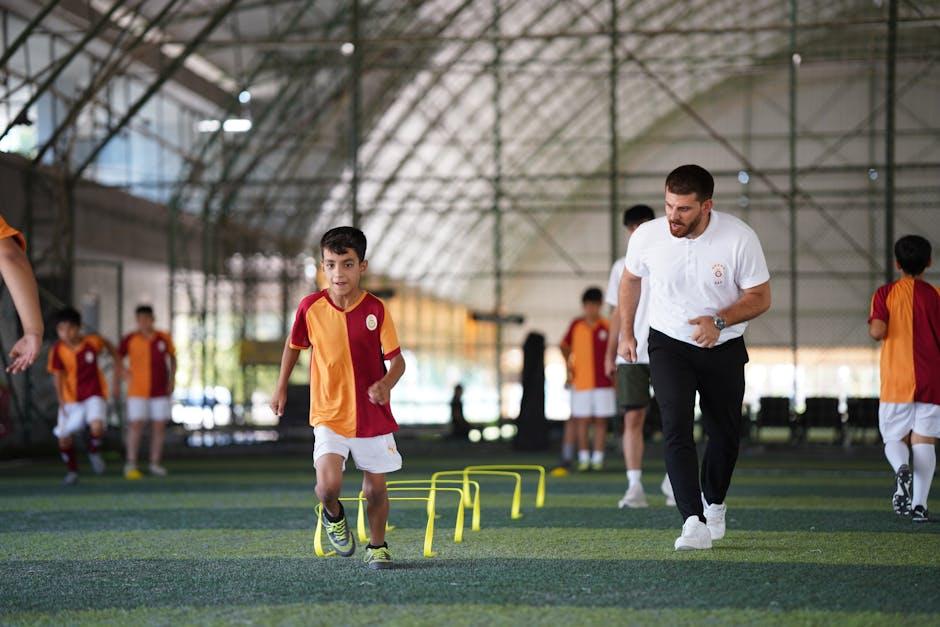In the pulsating heart of football, where split-second decisions and raw talent have long defined the beautiful game, a quiet revolution is unfolding. Beyond the roar of the crowds and the dazzling footwork on the pitch, numbers and data are weaving a new narrative—one where analytics shapes strategy, uncovers hidden patterns, and redefines what it means to win. From tracking player movements with precision to decoding opponent tactics through algorithms, analytics is transforming football into a sport as much about insight as instinct. This article explores how the marriage of data and deep-rooted tradition is reshaping football, illuminating the profound impact analytics has on every pass, goal, and glorious victory.
Table of Contents
- The Evolution of Data Collection in Modern Football
- Transforming Player Performance Through Advanced Metrics
- Strategic Decision Making Enhanced by Real-Time Analytics
- The Role of Analytics in Injury Prevention and Recovery
- Analyzing Opponent Patterns to Gain Competitive Advantage
- Integrating Analytics into Coaching Philosophy for Sustainable Success
- Q&A
- Concluding Remarks

The Evolution of Data Collection in Modern Football
As technology advanced, the methods of gathering football data transformed from simple manual notations into sophisticated, real-time digital tracking systems. Early data collection relied heavily on human observation and basic statistics like goals scored and fouls committed. However, the introduction of GPS trackers, video analysis software, and wearable sensors revolutionized how teams understand player performance and game dynamics. These tools provide detailed insights into speed, distance covered, heart rate, and even players’ positioning, making data not just supplementary but integral to tactical and physical preparation.
Today’s football analytics extend beyond individual metrics, incorporating machine learning and AI to predict outcomes and optimize strategies. Teams use multi-layered data to customize training regimes and execute evidence-based decision-making during matches. Some key elements driving this evolution include:
- Real-time processing: Instantaneous data delivery for live strategic adjustments.
- Comprehensive coverage: Tracking every player’s movements, gaps, and ball trajectories.
- Predictive analytics: Anticipating opponent’s tactics and player fatigue patterns.
- Integration platforms: Centralized dashboards consolidating diverse datasets.
| Era | Primary Data Sources | Key Benefit |
|---|---|---|
| Manual Compilations (Pre-2000s) | Written notes, Video review | Basic performance tracking |
| Early Digital (2000-2010) | Video analytics, GPS devices | Player movement insights |
| Modern Analytics (2010-Present) | Wearables, AI-powered tools, Real-time sensors | Strategic, predictive decision-making |

Transforming Player Performance Through Advanced Metrics
Today’s football landscape is being reshaped not just by talent but by data-driven insights that transcend traditional metrics. Teams now leverage sophisticated analytics to monitor aspects like player stamina, positioning, and decision-making in real-time. Instead of relying solely on subjective observation, coaches and analysts use these advanced metrics to craft personalized training regimens and tactical adjustments, leading to measurable improvements on the pitch. This evolution empowers players to optimize their strengths while addressing weaknesses with scientific precision.
Some key performance indicators that are transforming player evaluation include:
- Expected Goals (xG): quantifies scoring opportunities beyond simple shot counts.
- Heat Maps: visualize player movement and influence across the field.
- Pressing Efficiency: measures success in regaining possession under pressure.
- Recovery Runs: tracks defensive efforts to regain proper positioning.
| Metric | Impact on Training | Example Outcome |
|---|---|---|
| Passing Accuracy Under Pressure | Focuses on composure in tight situations | Reduced turnovers by 15% |
| Distance Covered at Sprint Speed | Enhances high-intensity endurance | 10% more sprints per match |
| Successful Aerial Duels | Improves timing and jump techniques | Increased possession retention |

Strategic Decision Making Enhanced by Real-Time Analytics
In today’s fast-paced football environments, the ability to make split-second decisions can define success or failure. Coaches and analysts leverage real-time analytics to monitor player performance, environmental conditions, and opposition tactics as the game unfolds. This dynamic influx of data empowers teams to adapt strategies instantly, such as switching formations, making targeted substitutions, or adjusting pressing intensity—actions that were once based purely on intuition or delayed video review.
Consider the tactical insights gained from assessing live metrics like pass completion rates, heat maps, and possession statistics. These insights enable managers to:
- Identify vulnerabilities in the opponent’s setup during the match.
- Optimize player roles based on real-time stamina and effectiveness.
- Enhance communication with data-driven feedback to players on the pitch.
| Metric | Impact on Decision | Example Use |
|---|---|---|
| Player Distance Covered | Rest Management | Substitution of fatigued players early |
| Pass Accuracy | Midfield Control | Adjust passing strategy to increase possession |
| Opponent Shot Locations | Defensive Positioning | Reinforce areas vulnerable to attacks |

The Role of Analytics in Injury Prevention and Recovery
In modern football, data analytics transcends traditional performance metrics by focusing heavily on injury prevention. Advanced wearable technology collects real-time physiological data such as workload, heart rate variability, and muscle strain, allowing teams to spot early signs of potential injuries. Coaches and medical staff then tailor training regimens based on these insights, balancing intensity with adequate recovery. This proactive approach not only reduces the risk of injuries but also extends players’ careers by preserving their physical health over demanding seasons.
Recovery strategies have also evolved through analytics, providing a quantified roadmap for rehabilitation. Data-driven models help in predicting recovery timelines and customizing rehabilitation exercises to optimize healing without risking setbacks. Below is a snapshot showcasing how analytics adjust recovery plans based on injury type and player response:
| Injury Type | Average Recovery Time | Data-Driven Adjustment |
|---|---|---|
| Hamstring Strain | 4-6 weeks | Load reduced by 30% during week 2 |
| ACL Tear | 6-9 months | Early mobility exercises introduced week 4 |
| Concussion | 7-14 days | Gradual increase in cognitive load, monitored daily |

Analyzing Opponent Patterns to Gain Competitive Advantage
Understanding an opponent’s tendencies has evolved beyond traditional scouting reports into the realm of detailed data analysis. By dissecting patterns such as preferred passing lanes, defensive setups, and pressing triggers, teams can craft tailored strategies that exploit inherent weaknesses. This in-depth examination allows coaches to predict likely opposition moves with greater accuracy, transforming instinct-based decisions into data-driven tactics that shift the balance of play before the whistle blows.
Key elements explored when analyzing opponent patterns include:
- Frequency and direction of attacks during different match phases
- Individual player behaviors in high-pressure situations
- Set-piece routines and variations to disrupt defensive organization
- Recovery speed and transition tendencies following ball loss
| Pattern | Role | Potential Exploit |
|---|---|---|
| High Defensive Line | Center-backs | Utilize quick through balls behind defenders |
| Frequent Left Flank Overlaps | Left-back & Winger | Counterattack exploiting right side spaces |
| Long Goalkeeper Distribution | Goalkeeper | Press forward players early to force errors |

Integrating Analytics into Coaching Philosophy for Sustainable Success
In the modern era of football, the fusion of data analytics with traditional coaching methods is revolutionizing the way teams and players approach the game. Coaches who embrace this synergy empower their squads with informed decision-making tools that extend beyond intuition. By leveraging real-time statistics, player tracking, and biomechanical data, they can tailor training sessions that enhance individual strengths and address weaknesses with precision. This data-driven mindset fosters a sustainable framework for development, ensuring that progress is not just momentary but built on consistent, measurable growth.
Integrating analytics also cultivates a culture of accountability and continuous improvement within the team. Key benefits include:
- Objective Performance Reviews: Clear metrics that provide unbiased assessments.
- Strategic Game Plans: Insights into opposition tendencies and optimal tactical adjustments.
- Injury Prevention: Data on player exertion levels to reduce overtraining and fatigue.
| Coaching Element | Analytical Advantage | Impact on Success |
|---|---|---|
| Training Intensity | Customized workload data | Reduced injuries, sustained peak fitness |
| Tactical Adjustments | Video + heat map analysis | Improved adaptability during matches |
| Player Development | Performance trend tracking | Targeted skill enhancement |
Q&A
Q&A:
Q1: What exactly does “analytics” mean in the context of football?
A1: In football, analytics refers to the systematic analysis of data derived from matches, player performances, and training sessions. This data-driven approach helps teams make informed decisions, from tactics and player recruitment to injury prevention and match strategy.
Q2: How has the integration of analytics changed the way football is played?
A2: Analytics has introduced a new layer of precision to the game. Coaches and players now benefit from detailed insights into opponents’ patterns, optimal positioning, and even stamina management. This has made football not only more strategic but also more adaptable during matches.
Q3: Are analytics replacing traditional scouting and coaching methods?
A3: Rather than replacing traditional methods, analytics complements them. Scouts and coaches still rely on experience and intuition, but analytics offers objective data that can validate or challenge their judgments, creating a balanced approach to decision-making.
Q4: What role does player data play in contract negotiations and transfers?
A4: Player statistics and performance metrics have become crucial bargaining chips in the transfer market. Clubs use analytics to assess a player’s value more accurately, reducing risks associated with expensive signings and ensuring better investment returns.
Q5: How do fans engage with analytics in football today?
A5: Fans increasingly enjoy access to real-time data, from expected goals (xG) to heat maps and pass completion rates, enhancing their understanding and enjoyment of the game. Fantasy football platforms and broadcast graphics have popularized analytics, making it a staple of modern fandom.
Q6: Are there any challenges associated with the rise of analytics in football?
A6: Yes, overreliance on data can sometimes overlook the human elements like creativity and morale. Additionally, the quality of data and the interpretation skills of analysts can vary greatly, potentially leading to misleading conclusions if not handled carefully.
Q7: What does the future hold for analytics in football?
A7: The future of analytics in football is bright and likely to deepen with advancements in AI, wearable technology, and real-time data processing. These innovations promise even more personalized training regimes, smarter tactics, and an enriched experience both on and off the pitch.
Concluding Remarks
As the final whistle blows on our exploration of analytics in football, one thing is clear: numbers have become an integral part of the beautiful game’s ever-evolving story. From pinpointing player potential to shaping tactical masterpieces, analytics brings a new dimension to how football is played, understood, and enjoyed. Yet, behind every stat lies the human spirit—the creativity, passion, and unpredictability that no data set can fully capture. In the end, analytics doesn’t replace the art of football; it enhances its canvas, drawing sharper lines and richer shades to a game that continues to inspire millions worldwide.


